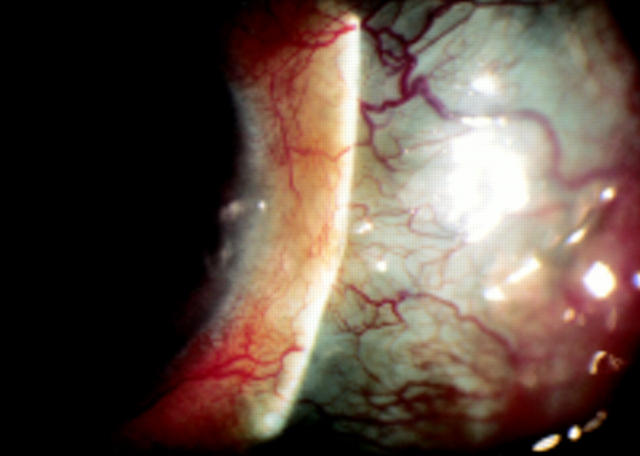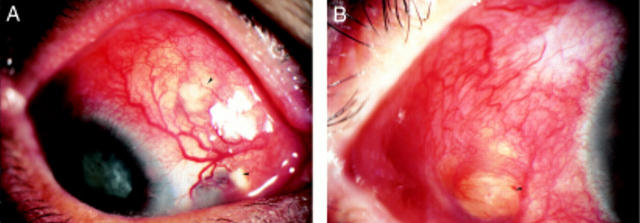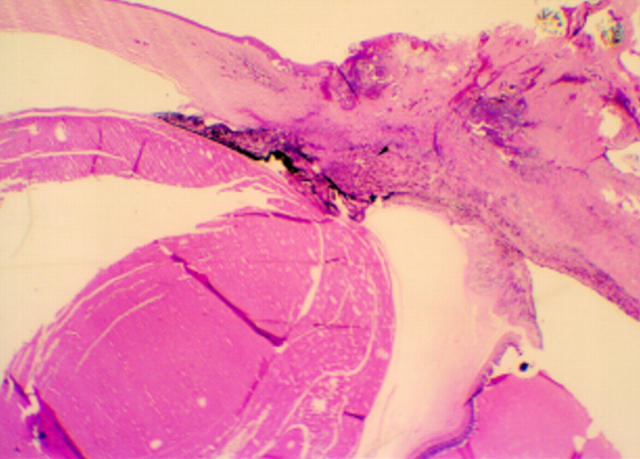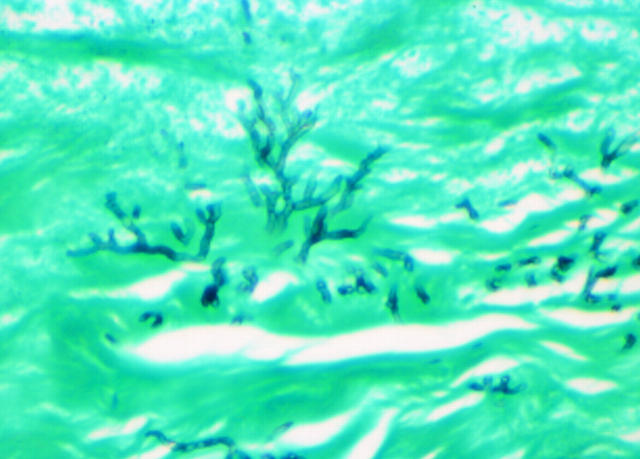Abstract
AIMS—To assess the clinical pictures, possible pathogenesis, management, and therapy of patients with infectious scleritis associated with multifocal scleral abscesses following pterygium excision. METHODS—The records of patients with infectious scleritis after pterygium excision who developed multifocal scleral abscesses presenting from 1988 to the end of 1995 were reviewed. Early culture of abscesses was performed, and topical, systemic antimicrobials, or both were given to all patients. Fourteen eyes were operated on in addition to antimicrobial treatment. RESULTS—The initial culture reports of scleral ulcers identified Pseudomonas species in 12 of these 18 patients, Aspergillus in one, Mycobacterium fortuitum in one, and mixed organisms in four. Subsequent abscess cultures were taken from 15 of the infected eyes, and revealed the same organism as the initial culture in 12. Associated complications included four serous retinal detachments, three choroidal detachments, two double detachments, five complicated cataracts, and four recurrences of the initial infection. Four eyes required eventual enucleation and 11 eyes regained useful vision. CONCLUSIONS—With subsequent abscess cultures proving to be the same organism as found in the initial ulcer, the abscess formation appears to represent intrascleral dissemination. Early diagnosis and appropriate, prolonged topical plus systemic antimicrobial treatment are essential to halt the progression of such severe infections. Keywords: infectious scleritis; scleral abscess; pterygium excision
Full Text
The Full Text of this article is available as a PDF (162.1 KB).
Figure 1 .
Case 1. Scleral thinning from original ulcer through subsequent abscess extended in an arc shape.
Figure 2 .
Case 5. (A) Multiple scleral abscesses (arrowheads) developed 3 weeks after excision of a nasal pterygium with mitomycin C used as adjunct. (B) A new abscess (arrowhead) at the temporal sclera, 180° from the initially involved area, was noted 1 month after discharge.
Figure 3 .
Case 13. (A) At presentation there was a calcific plaque over the scleral ulcer bed (arrowhead). The ulcer progressed and became contiguous with a corneal infiltrate (arrow). (B) Multiple new nodules (arrowheads) from which P aeruginosa was cultured, appeared on the 22nd day of hospitalisation.
Figure 4 .
Case 13. Chronic inflammatory cells infiltrated the supraciliary space (arrowhead) (haematoxylin and eosin, × 5).
Figure 5 .
Fungal elements were present in the enucleated specimen from case 3 (Gomori's methenamine silver, × 230).
Selected References
These references are in PubMed. This may not be the complete list of references from this article.
- Alfonso E., Kenyon K. R., Ormerod L. D., Stevens R., Wagoner M. D., Albert D. M. Pseudomonas corneoscleritis. Am J Ophthalmol. 1987 Jan 15;103(1):90–98. doi: 10.1016/s0002-9394(14)74175-3. [DOI] [PubMed] [Google Scholar]
- Altman A. J., Cohen E. J., Berger S. T., Mondino B. J. Scleritis and Streptococcus pneumoniae. Cornea. 1991 Jul;10(4):341–345. doi: 10.1097/00003226-199107000-00010. [DOI] [PubMed] [Google Scholar]
- Altman A. J., Cohen E. J., Berger S. T., Mondino B. J. Scleritis and Streptococcus pneumoniae. Cornea. 1991 Jul;10(4):341–345. doi: 10.1097/00003226-199107000-00010. [DOI] [PubMed] [Google Scholar]
- Berler D. K., Alper M. G. Scleral abscesses and ectasia caused by Pseudomonas aeruginosa. Ann Ophthalmol. 1982 Jul;14(7):665–667. [PubMed] [Google Scholar]
- Dougherty P. J., Binder P. S., Mondino B. J., Glasgow B. J. Acanthamoeba sclerokeratitis. Am J Ophthalmol. 1994 Apr 15;117(4):475–479. doi: 10.1016/s0002-9394(14)70007-8. [DOI] [PubMed] [Google Scholar]
- Farrell P. L., Smith R. E. Bacterial corneoscleritis complicating pterygium excision. Am J Ophthalmol. 1989 May 15;107(5):515–517. doi: 10.1016/0002-9394(89)90496-0. [DOI] [PubMed] [Google Scholar]
- HARBIN T. RECURRENCE OF A CORNEAL PSEUDOMONAS INFECTION AFTER TOPICAL STEROID THERAPY: REPORT OF A CASE. Am J Ophthalmol. 1964 Oct;58:670–674. doi: 10.1016/0002-9394(64)91386-8. [DOI] [PubMed] [Google Scholar]
- Lin C. P., Wu Y. H., Chen M. T., Huang W. L. Repair of a giant scleral ulcer with a scleral graft and tissue glue. Am J Ophthalmol. 1991 Feb 15;111(2):251–251. doi: 10.1016/s0002-9394(14)72275-5. [DOI] [PubMed] [Google Scholar]
- MacKenzie F. D., Hirst L. W., Kynaston B., Bain C. Recurrence rate and complications after beta irradiation for pterygia. Ophthalmology. 1991 Dec;98(12):1776–1781. doi: 10.1016/s0161-6420(91)32051-7. [DOI] [PubMed] [Google Scholar]
- Margo C. E., Polack F. M., Hood C. I., Mood C. I. Aspergillus panophthalmitis complicating treatment of pterygium. Cornea. 1988;7(4):285–289. [PubMed] [Google Scholar]
- Moriarty A. P., Crawford G. J., McAllister I. L., Constable I. J. Fungal corneoscleritis complicating beta-irradiation-induced scleral necrosis following pterygium excision. Eye (Lond) 1993;7(Pt 4):525–528. doi: 10.1038/eye.1993.114. [DOI] [PubMed] [Google Scholar]
- Moriarty A. P., Crawford G. J., McAllister I. L., Constable I. J. Severe corneoscleral infection. A complication of beta irradiation scleral necrosis following pterygium excision. Arch Ophthalmol. 1993 Jul;111(7):947–951. doi: 10.1001/archopht.1993.01090070065021. [DOI] [PubMed] [Google Scholar]
- Raber I. M., Laibson P. R., Kurz G. H., Bernardino V. B. Pseudomonas corneoscleral ulcers. Am J Ophthalmol. 1981 Sep;92(3):353–362. doi: 10.1016/0002-9394(81)90524-9. [DOI] [PubMed] [Google Scholar]
- Ram J., Sharma A., Gupta A. Multiple scleral abscesses with recurrent bacterial endophthalmitis eight months following cataract surgery. Acta Ophthalmol (Copenh) 1990 Oct;68(5):615–616. doi: 10.1111/j.1755-3768.1990.tb04800.x. [DOI] [PubMed] [Google Scholar]
- Reynolds M. G., Alfonso E. Treatment of infectious scleritis and keratoscleritis. Am J Ophthalmol. 1991 Nov 15;112(5):543–547. doi: 10.1016/s0002-9394(14)76856-4. [DOI] [PubMed] [Google Scholar]
- Sainz de la Maza M., Foster C. S. Necrotizing scleritis after ocular surgery. A clinicopathologic study. Ophthalmology. 1991 Nov;98(11):1720–1726. doi: 10.1016/s0161-6420(91)32062-1. [DOI] [PubMed] [Google Scholar]
- Tarr K. H., Constable I. J. Late complications of pterygium treatment. Br J Ophthalmol. 1980 Jul;64(7):496–505. doi: 10.1136/bjo.64.7.496. [DOI] [PMC free article] [PubMed] [Google Scholar]
- Tarr K. H., Constable I. J. Pseudomonas endophthalmitis associated with scleral necrosis. Br J Ophthalmol. 1980 Sep;64(9):676–679. doi: 10.1136/bjo.64.9.676. [DOI] [PMC free article] [PubMed] [Google Scholar]







